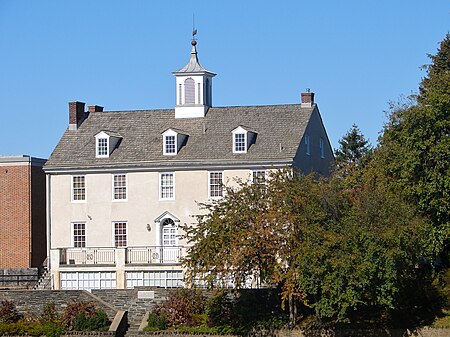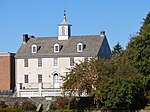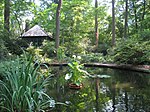Bala Cynwyd, Pennsylvania

Bala Cynwyd ( BAL-ə KIN-wuud) is a community in Lower Merion Township, Pennsylvania, United States. It is located on the Philadelphia Main Line in Southeastern Pennsylvania and borders the western edge of Philadelphia at U.S. Route 1 (City Avenue). The present-day community was originally two separate towns, Bala and Cynwyd, but was united as a singular community largely because the U.S. Post Office, the Bala Cynwyd branch, served both towns using ZIP Code 19004. The community was long known as hyphenated Bala-Cynwyd. Bala and Cynwyd are currently served by separate stations on SEPTA's Cynwyd Line of Regional Rail. Bala Cynwyd lies in the Welsh Tract of Pennsylvania and was settled in the 1680s by Welsh Quakers, who named it after the town of Bala and the village of Cynwyd in Wales. A mixed residential community made up predominantly of single-family detached homes, it extends west of the Philadelphia city limits represented by City Avenue from Old Lancaster Road at 54th Street west to Meeting House Lane and then along Manayunk and Conshohocken State Roads north to Mary Watersford Road, then east along Belmont Avenue back to City. This large residential district contains some of Lower Merion's oldest and finest stone mansions, built mainly from 1880 through the 1920s and located in the sycamore-lined district between Montgomery Avenue and Levering Mill Road, as well as split level tract houses built east of Manayunk Road just after World War II.
Excerpt from the Wikipedia article Bala Cynwyd, Pennsylvania (License: CC BY-SA 3.0, Authors, Images).Bala Cynwyd, Pennsylvania
Concord Circle, Lower Merion Township
Geographical coordinates (GPS) Address Nearby Places Show on map
Geographical coordinates (GPS)
| Latitude | Longitude |
|---|---|
| N 40.0075 ° | E -75.234166666667 ° |
Address
Concord Circle
19004 Lower Merion Township
Pennsylvania, United States
Open on Google Maps










